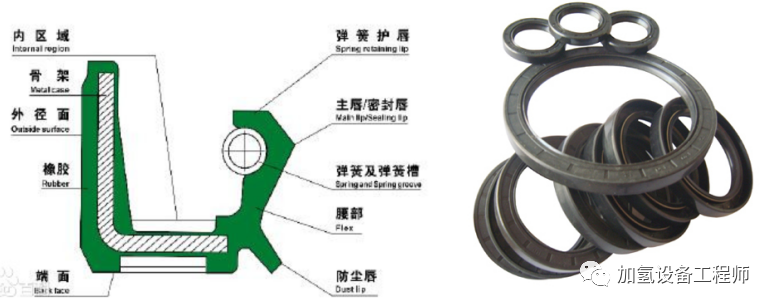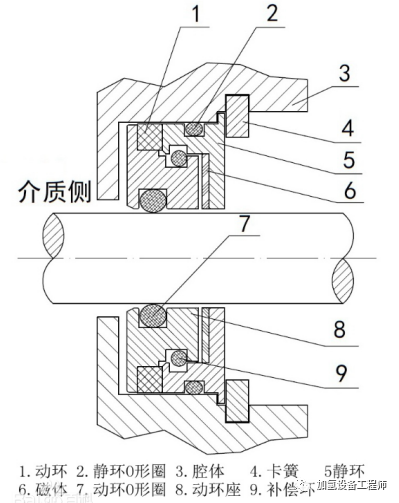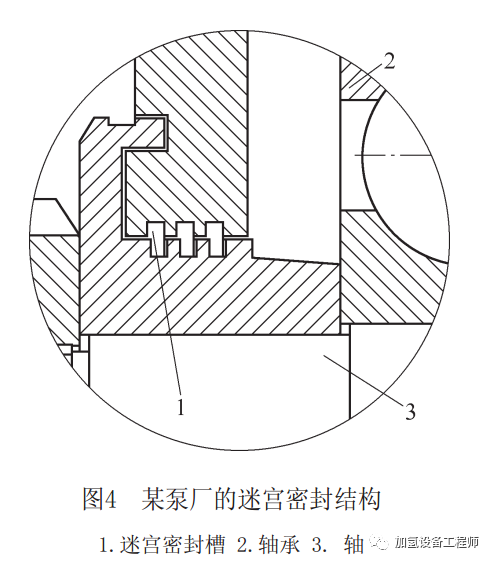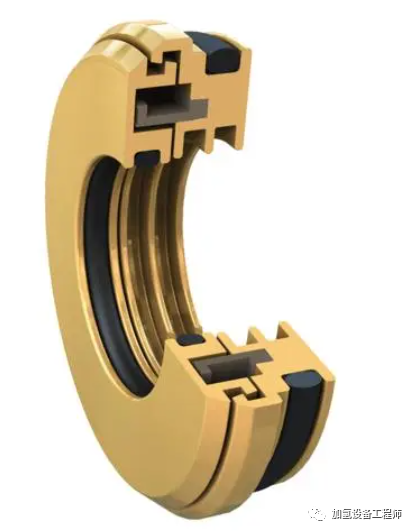-





- hzvberings@gamil.com
- Industry Knowledge
2023-07-12
The role of the oil seal is generally to isolate the parts that need lubrication in the transmission parts from the external environment, so that the lubricating oil will not leak. Skeleton oil seal is a typical representative of oil seal, generally speaking, oil seal refers to skeleton oil seal. In addition, there are magnetic oil seals, labyrinth oil seals, bearing isolators and so on.
A, skeleton oil seal
1.1 Classification and Structure of skeleton oil seal
Skeleton oil seal is a typical representative of oil seal, generally speaking, the oil seal refers to the skeleton oil seal. The skeleton is like the steel bar inside the concrete member, which acts as a reinforcement and allows the oil seal to maintain its shape and tension. According to the structure, it can be divided into single lip skeleton oil seal and double lip skeleton oil seal. The secondary lip of the double lip skeleton oil seal plays a dust-proof role to prevent external dust, impurities, etc., from entering the inside of the machine. According to the type of skeleton, it can be divided into internal skeleton oil seal, exposed skeleton oil seal and assembled oil seal.
The skeleton oil seal structure consists of three parts: the oil seal body, the reinforced skeleton and the self-tightening helical spring. The sealing body is divided into the bottom, waist, cutting edge and sealing lip according to different parts. Generally, the inner diameter of the skeleton oil seal in the free state is smaller than the shaft diameter, that is, it has a certain “ Amount of interference ” .

Figure 1 Skeleton oil seal
Therefore, when the oil seal is loaded into the oil seal seat and shaft, the pressure of the oil seal cutting edge and the contraction force of the self-tightening spiral spring produce a certain radial tightening force on the shaft, and after a period of running, the pressure will rapidly reduce or even disappear, so that the spring can compensate the self-tightening force of the oil seal at any time.
1.2 Skeleton oil seal sealing principle
Sealing principle: Because there is an oil film controlled by the edge of the oil seal between the oil seal and the shaft, the oil film has fluid lubrication characteristics. Under the action of the liquid surface tension, the stiffness of the oil film just makes the oil film and the air contact end form a crescent surface, preventing the leakage of the working medium, so as to achieve the sealing of the rotating shaft. The sealing ability of the oil seal depends on the thickness of the oil film on the sealing surface. If the thickness is too large, the oil seal will leak. If the thickness is too small, dry friction may occur, causing oil seal and shaft wear; There is no oil film between the seal lip and the shaft, which is easy to cause heat and wear.
Therefore, in the installation, it is necessary to apply some oil on the sealing ring, while ensuring that the skeleton oil seal is perpendicular to the axis line, if not vertical, the sealing lip of the oil seal will drain the lubricating oil from the shaft, which will also lead to excessive wear of the sealing lip. During operation, the lubricant in the shell exudes a little to achieve the ideal state of forming an oil film at the sealing surface.
1.3 Sealing effect of skeleton oil seal
The function of the skeleton oil seal is generally to isolate the parts that need lubrication in the transmission parts from the output parts, so as not to let the lubricating oil leak, which is usually used for the rotary shaft, which is a rotary shaft lip seal. The skeleton is like the steel bar inside the concrete member, which acts as a reinforcement and allows the oil seal to maintain its shape and tension. The skeleton oil seal is made of high quality nitrile butadiene rubber and steel plate with stable quality and long service life. Widely used in crankcase, gearbox, bearing box and other parts.
Rational use of oil seal, should pay attention to the following points:
(1) Shaft speed Due to design and structural reasons, high-speed oil seals should be used for high-speed shafts, low-speed shafts should use low-speed oil seals, and low-speed oil seals should not be used for high-speed shafts, and vice versa.
(2) Ambient temperature In the case of high use temperature, polypropylene ester or silicon, fluorine, silicone fluorine rubber should be selected. And try to reduce the oil temperature in the tank. In the case of too low temperature, cold resistant rubber should be used.
(3) pressure The general oil seal has poor pressure resistance, and the oil seal will deform when the pressure is too large. Under excessive pressure conditions, pressure bearing rings or strengthened pressure oil seals should be used.
(4) The degree of eccentricity on the installation of the oil seal and the shaft when the eccentricity is too large, the sealing will become worse, especially when the shaft speed is high. If the eccentricity is too large, it can be used “ W” Shaped section of the oil seal.
(5) The surface finish of the shaft directly affects the service life of the oil seal, that is, the higher the finish of the shaft, the longer the service life of the oil seal.
(6) Note that there should be a certain amount of lubricating oil on the lip of the oil seal.
(7) Special attention should be paid to prevent dust from immersing in the oil seal.
Two, magnetic oil seal
2.1 Introduction to Magnetic Oil Seal
Magnetic oil seal is composed of two parts of the static ring and the dynamic ring, the use of magnetic technology, the use of machine seal concept, full floating sealing surface structure.

Figure 2 Magnetic oil seal
Oil seal is a mechanical component used to seal oil, which isolates the parts that need lubrication in the transmission parts from the output parts, so that the lubricating oil will not leak. Static seals and dynamic seals are called seals.
Magnetic oil seal is a product designed after years of research and experiments, creative use of modular magnetic compensation system and new material sealing technology, simple installation can solve the problem that has been difficult to eradicate in industrial history. It not only responds to the national policy of green environmental protection for product transformation and upgrading, but also meets the 6S management requirements of factory enterprises.
Traditional lip seal products are bound to have friction with the axial surface in application, and are easy to fail in application. The bearing chamber cannot be effectively prevented from being contaminated, and the working life is generally short and difficult to control. When the lip seal leaks, the loss of lubricating oil will bring disastrous consequences to the bearing and equipment. The equipment damage caused by severe wear and tear will inevitably increase the repair cost.
Magnetic oil seal in the design of the use of magnetic technology, the use of machine seal concept, full floating sealing surface structure. The overall structure is simple, easy to install, and less power consumption. Less dynamic and static ring consumption. The coupling surface of dynamic and static rings is always in close contact, and effective sealing can be achieved even under large shaft runout. The replacement of skeleton oil seal by magnetic seal is the inevitable direction of the development of shaft seal technology.
2.2 Function Configuration of Magnetic Oil seal
Magnetic oil seal is composed of static ring and dynamic ring:
Static ring, which is stable and wear-resistant in case of heat “ 316 stainless steel ” It is fixed in the cavity through O-ring, and the dynamic sealing surface is smooth and wear-resistant.
Dynamic ring, containing magnetic elements, dynamic sealing surface is made of carbon composite material with excellent heat dissipation and wear resistance, and adopts floating design. It can maintain the fit under the attraction of the static ring for a long time. In order to achieve long-term attraction with the static ring, the magnetic components of the magnetic oil seal are made of permanent magnet materials that will not degaussing under high temperature environment. And in order to meet the requirements of floating design, the dynamic ring is fixed on the shaft with an O-ring.
Magnetic oil seal in the structural design to take into account the long life of use, so the use of special materials, so that it can be durable in harsh environments and repeated changes. The magnetic oil seal can work in dry or lubricated conditions, and is also suitable for water erosion. Rotary equipment such as speed reducers, gearboxes, fans, pumps and motors can be used in vertical, horizontal, low speed, high speed, dry friction or lubrication conditions.
2.3 Magnetic Oil Seal Characteristics
(1) Magnetic compensation seal design, suitable for lubrication or dry friction conditions, truly zero leakage.
(2) The magnetic oil seal has no requirement for the surface hardness of the shaft, and will not wear the shaft.
(3) The linear speed of the magnetic oil seal can reach 50 m/s.
(4) The life of the magnetic oil seal is longer than that of the traditional oil seal, with a minimum of 28000h.
Three, labyrinth oil seal
Labyrinth seal is a non-contact dynamic seal. By forming a plurality of sealing slots between the rotating parts and fixed parts, resistance is generated to prevent the leakage of liquid (gas) (as shown in Figure 3).

Because the labyrinth seal is non-contact, there is a certain gap between the rotating part and the fixed part, so there is no wear and damage. However, the labyrinth seal has high requirements for the coaxiality of the rotating parts and the fixed parts, and if the two parts are different, it is easy to produce friction and burn the parts. Moreover, the processing difficulty of labyrinth seals is relatively high.
Labyrinth seals are generally used on horizontal slurry pumps lubricated by non-pressurized thin oil. FIG. 4 shows the labyrinth seal structure of a pump factory. This design integrates the three kinds of labyrinth sealing structures in Figure 3, which not only ensures the sealing effect, but also makes the processing and assembly more convenient and fast; At the same time, it also plays a protective role in the bearing, preventing external dust and water from entering the bearing and the housing. Practice has proved that this kind of labyrinth sealing design is quite good in use. However, this design has a requirement that the oil level of the lubricating oil cannot be higher than the position of the sealing tank, otherwise the lubricating oil will automatically leak. This in turn limits the scope of application of this labyrinth seal. If the oil level is high or other lubrication methods also use labyrinth seals, then a parking seal is required. The parking seal is a rubber seal similar to the oil seal, once damaged, the entire sealing structure and even the entire equipment need to stop and repair.

Four, bearing isolator
Bearing isolator is a non-contact, non-wear permanent bearing protection device developed on the basis of compound labyrinth seal. Generally divided into labyrinth bearing isolators and magnetic bearing isolators. The labyrinth bearing isolation consists of a moving ring and a static ring, which are combined into one, so that the two do not separate during operation. Generally speaking, the moving ring rotates with the shaft, and the mounting part of the static ring is pressed into the bearing box end cover. The dynamic and static ring synergies prevent external pollutants from entering the bearing box and prevent the leakage of lubricating media. High quality bearing isolators are finished from metal materials, usually brass, and are equipped with a steam blocking ring that blocks the free entry and exit of external water vapor. This prevents the external water vapor from being drawn backwards into the bearing box when the equipment is shut down due to the cooling of the air inside the bearing box, thereby reducing the lubricant lubrication performance. The sealing performance of the bearing isolator does not degrade over time, which allows it to provide long-lasting bearing protection for rotating equipment.

Figure 5 Bearing isolator
Advantages of bearing isolators
Before the invention of bearing isolators, the protective barriers of bearings of rotating equipment mainly used lip seals or end seals such as skeleton oil seals or labyrinth seals. The rubber skeleton oil seal, for example, has a maximum service life of only 3,000 hours, but is used to protect rolling bearings with a design life of up to 50,000 hours (about 6 years). With the weakening of the sealing performance of the skeleton oil seal, it begins to scratch the surface of the shaft, or the sealing lip is aging, so that the sealing performance is rapidly lost. And because the skeleton oil seal wear caused by shaft damage, the cost is high, in addition, due to the leakage of lubricants and the intrusion of pollutants, affect the service life of the bearing, and even cause downtime accidents. All contact seals, due to their own characteristics, will produce wear and energy loss. The working life and energy consumption of a 3-inch (about 76mm) rubber skeleton oil seal was tested at 2550 RPM, and the results showed that the failure rate of an ordinary skeleton oil seal was more than 90% within 1500 hours. Even the imported brand of skeleton oil seal, its actual working life will not exceed 3000 hours, and after the seal lip scratches the shaft, the sealing effect will become more and more unsatisfactory. At present, many key equipment manufacturing standards (such as API610 chemical pumps, IEEE-841 motors) require that their seals must be able to operate continuously for 5 years and be maintenance-free. Therefore, the skeleton oil seal is not suitable for industrial equipment that requires continuous operation, such as pumps, motors, gearboxes and steam engines in the processing industry. Computer wait. The average power consumption of each frame oil seal is 150W.
The power consumption of general oil seals is related to the following factors: (1) shaft diameter, speed, shaft surface finish; (2) lubricating oil viscosity; (3) Temperature; (4) Seal lip material. If an enterprise installs a large number of rotating equipment and runs continuously all year round, its annual power consumption and maintenance costs will be very objective, which is not conducive to the energy conservation and consumption reduction of enterprises. The improvement of efficiency. Bearing isolator as a non-contact, frictionless sealing device, its no shaft, no power consumption, no maintenance, zero leakage characteristics, can better meet the needs of the current working conditions of enterprise equipment sealing. Its main advantages: (1) non-contact, non-wear durable bearing protection; (2) Steam blocking ring can block the steam intrusion caused by the heating or cooling of the bearing box; (3) Provide split type design, easy to install; (4) Maintenance free; (5) Zero energy consumption; (6) The standard tolerance temperature range is -37 ~ 204º C; (7) Made of copper, stainless steel, aluminum or other materials to adapt to extreme conditions.
Labyrinth bearing isolator as an improvement of rubber seal and labyrinth seal, is a composite labyrinth seal with a unique design structure, generally made of corrosion-resistant and heat-dissipating tin bronze processing, and equipped with fluorine rubber material static seal, truly realize zero leakage of rotating equipment, and no maintenance. Service life can reach decades, can block the outside ash
 Product catalog
Product catalog
 Wechat
Wechat
 移动端
移动端
 Mobile website
Mobile website
Have questions about solutions, products, or other issues?
Please contact us and we will get back to you as soon as possible.
Shandong Zhengyi Bearing Manufacturing Co., Ltd
Address:No. 598-1, North Zhufeng Street, Wafangdian Bearing Industry Park, Dalian City, Liaoning Province
Telephone:+86 635-2876543
Mobile Phone:+86 13561222997 +86 15266876543